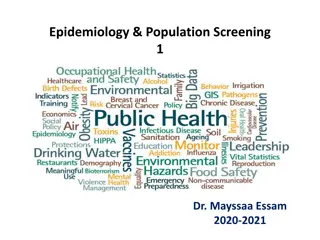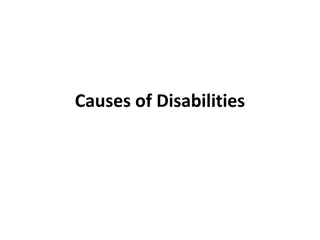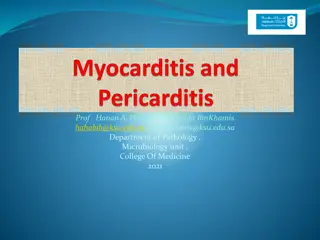Understanding Malignant Hyperthermia: Causes, Management, and Epidemiology
Malignant Hyperthermia (MH) is a genetic disorder of skeletal muscle triggered by certain anesthetics, leading to a hyper-metabolic state. The uncontrolled release of calcium results in muscle rigidity, metabolic acidosis, hyperthermia, and other serious complications. MH was first described in the 1960s, and management involves prompt recognition, dantrolene administration, and specialized perioperative care. Incidence varies, with mortality rates decreasing due to improved treatment. Patients with Muscular Dystrophy may not be at higher risk, but certain conditions like King-Denborough Syndrome and Central Core Disease are associated with MH susceptibility.
Download Presentation

Please find below an Image/Link to download the presentation.
The content on the website is provided AS IS for your information and personal use only. It may not be sold, licensed, or shared on other websites without obtaining consent from the author. Download presentation by click this link. If you encounter any issues during the download, it is possible that the publisher has removed the file from their server.
E N D
Presentation Transcript
Malignant Hyperthermia Christopher Heine, MD Assistant Professor Medical University of South Carolina Charleston, SC Date updated: 4/2018
Disclosures None
Learning Objectives Review a brief history of MH Background and Epidemiology Discuss the Pathophysiology/Mechanism of MH Describe the presentation of an MH reaction and its differential diagnosis Review the Perioperative Management of a suspected MH-susceptible patient Management of an MH event Postoperative Counseling options Description of how to have facility prepared
History First described in Lancet in 1960 by Denborough & Lovell (1) Metabolic error of metabolism identified as source of MH by Kalow & Britt in 1970 (2) Dantrolene as treatment first described by Harrison in 1975 (in swine model) (3) Ryanodine Receptor identified as source of pathology in 1988 by Mickelson et al (4)
Background Genetic disorder of skeletal muscle that, when triggered, results in a hyper-metabolic process Most common triggers: Succinylcholine Volatile Anesthetics Nitrous Oxide is safe
Background Hypermetabolism is result of uncontrolled release of calcium from the Sarcoplasmic Reticulum of muscle cells, resulting in: Sustained muscle contraction/rigidity Mixed metabolic/respiratory acidosis Hypercarbia, Hyperthermia, Tachycardia Myoglobinuria Disseminated Intravascular Coagulopathy
Epidemiology Incidence varies from 1:40,000-1:250,000, but may be as high as 1:15,000 in children Prevalence of MH susceptibility may be as high as 1:3,000 (5) United States Mortality from MH episode: Prior to Dantrolene, as high as 70% 1987-2006 1.4% 2007-2012 9.5% (6)
Associated Disorders Historically, Muscular Dystrophy (MD) patients thought to be at higher risk for MH Evidence shows that MD patients are in fact at no higher risk than the general population BUT the same triggering agents can cause hyperkalemia and rhabdomyolysis in MD patients 3 Diseases with clearest association with MH King-Denborough Syndrome Central Core Disease Multiminicore Disease
Pathophysiology Normal Contraction Acetylcholine is released at the neuro-muscular junction and binds to nicotinic receptors resulting in depolarization Depolarization of the Transverse Tubules results in a change to the Dihydropyridine Receptors which opens the Ryanodine Receptors, resulting in Calcium release into the myoplasm Calcium binds to Troponin-C which allows the interaction of actin and myosin resulting in contraction Muscle relaxation is the result of Calcium-ATPase transporting Calcium back into the Sarcoplasmic Reticulum
Pathophysiology Malignant Hypertension Susceptible Most commonly the result of a mutation in the Ryanodine Receptor Mutation results in an increased influx of Calcium from the Sarcoplasmic Reticulum which causes the marked contracture, hyper-metabolism, and rhabdomyolysis Abnormal relaxation occurs as the Ryanodine Receptor does not close normally The precise mechanism behind the triggering agents and their interaction with Ryanodine Receptors is unclear
Pathophysiology Genetics Autosomal dominant with incomplete penetrance Ryanodine Receptor mutations are responsible for 50- 70% of the MH susceptible patients Located on Chromosome 19 Dihydropyridine Receptor mutations on Chromosomes 1 and 7 have also been identified as possible sources Genetic complexity may be responsible for variation in severity and clinical presentation Also means that genetic testing s role, although valuable, is not definitive for diagnosis Additional Sources listed below (7-10)
Presentation Hyper-metabolic syndrome following exposure to triggering agent* Usually signs occur shortly after exposure, but they can occur post- operatively First sign is usually an increase in End-Tidal CO2(ETCO2) that is not amenable to increasing minute ventilation Tachycardia, hypertension, tachypnea (if spontaneously ventilating) are non-specific but common Masseter spasm and muscle rigidity Hyperthermia can be an early or late finding Presenting respiratory acidosis eventually mixes with a metabolic acidosis Rhabdomyolysis, hyperkalemia, and cardiac arrhythmias/arrest can occur if left untreated
Differential Diagnosis Simple explanations like hyperthermia due to warm air mattresses, hypercarbia due to hypoventilation, tachycardia due to inadequate anesthesia Sepsis, Thyroid Storm, Pheochromocytoma, Drug Intoxication, Neuroleptic Malignant Syndrome, Serotonin Syndrome Regionally appropriate inclusions like Dengue Fever or Malaria Despite previous belief, there are no areas that are immune to MH susceptibility*
Preoperative Management If patient or family member has a known history of MH, they likely should receive a non-triggering anesthetic No benefit to prophylactic Dantrolene use Room preparation Succinylcholine placed somewhere it can t be accidentally administered Rapid Sequence Intubation can be done with 1.2mg/kg Rocuronium if necessary Vaporizer Canisters removed or taped to prevent administration CO2 absorbent, circuit, and reservoir bag replaced
Preoperative Management Machine Preparation Clears the machine of any residual volatile anesthesia Traditionally, continuous fresh gas flow (FGF) of 10L/min for at least 20 minutes was considered adequate to flush the machine Specific guidelines dependent on machine type Newer machines may require at least 120 minutes Maintain FGF of 10L/min throughout case to avoid volatile anesthesia concentration rebound Alternatively, charcoal filters can be placed on the inspiratory and expiratory limbs following a 90 second flush With FGF of at least 3L/min, the filters have been shown to maintain volatile concentration at <5ppm for up to 12 hours (13) Although possibly not an option in some locations, a dedicated MH machine that has never been exposed to volatile anesthesia or the use of an ICU ventilator have been utilized
Intraoperative Management Monitoring Standard monitors including pulse oximeter, ECG, Non- invasive Blood Pressure, and Wave Form Capnography Core temperature monitoring, ideally, if procedure >30 minutes Diagnosis Variable presentation, as mentioned earlier If suspicious, an ABG and VBG (if available) should be obtained ABG to determine severity of acidosis VBG to help determine if a hypermetabolic process is ongoing
Intraoperative Management Treatment The earlier an MH episode is recognized and treated, the better patients do Turn off volatile anesthetics and hyperventilate with 100% Oxygen Inform the surgeon and discuss aborting or finishing the procedure as quickly as possible Call for help and resuscitation drugs (MH Cart) Call the Malignant Hyperthermia Association of the United States (MHAUS) at their international phone number 1-(209)-417-3722 If available, charcoal filters can be placed on the circuit Treat the patient with Dantrolene
Intraoperative Management Dantrolene (Dantrium, Ryanodex) Hydantoin derivative that inhibits Calcium release Dantrium packaged as a lypholized powder with 20mg of Dantrolene and 3g of mannitol Each vial must be reconstituted with 60cc of sterile water and shaken until the solution is clear-orange in color 22 minute reconstitution time for a single dose Administered preferably through a large vein Ryanodex, a newer formulation, has 250mg of Dantrolene and 150mg of mannitol Each vial needs to be reconstituted with 5cc of sterile water 1 minute reconstitution time for a single dose Dosing Regardless of Dantrolene formulation, the dosing is the same Initial Bolus 2.5mg/kg Repeat bolus until signs of MH subside Occasionally requires doses as high as 20-30 mg/kg, but once more than 10mg/kg has been given, another diagnosis on your differential should be considered as well Administration may result in weakness, so appropriate airway management is recommended If Dantrolene is not available, symptomatic treatment is the best option Other Calcium Channel blockers do not treat an MH episode
Intraoperative Management Symptomatic Treatment Hyperthermia If doesn t respond to Dantrolene, external or internal cooling Foley catheter to monitor urine output Diurese to urine output of 1cc/kg/hr Dantrium contains 3g of mannitol per vial, but Ryanodex only contains 150mg, so particularly with Ryanodex, further diuretic use may be necessary Arterial Line for blood pressure and labs (Creatine Kinase and Myoglobin) Metabolic Acidosis Sodium Bicarbonate Hyperkalemia Calcium, Bicarbonate, Insulin/Glucose, Beta Agonist, Hyperventilation Cardiac Arrhythmias Treat per ACLS and PALS guidelines With the exception that calcium channel blockers in presence of Dantrolene may worsen cardiovascular collapse
Postoperative Management As blood levels of Dantrolene drop, its possible to get another MH reaction after the initial episode has subsided (recrudescence) MHAUS recommends either administering 1mg/kg of Dantrolene every 6 hours, starting an infusion at 0.25mg/kg/min, or just monitoring closely for 24-48 hours Serial Serum Creatine Kinase for 24-48 hours Diuresis and Alkalization to prevent myoglobin accumulation If patient has a known history of MH and undergoes an uneventful, triggering-agent free anesthetic, they can be discharged same day
Counseling/Testing Clinical presentation can guide diagnosis to a certain extent (14) For more definitive diagnosis, requires further testing which involve muscle biopsies that must be done at testing center Caffeine-Halothane Contracture Test (CHCT) Done in 5 locations in North America In-Vitro Contracture Test (IVCT) Europe Depending on results of CHCT or IVCT, patients can be referred for genetic testing, which only requires that a sample be sent to a testing center
MH Preparedness MHAUS website www.mhaus.org MHAUS hotline international phone number 1-(209)-417-3722 iPhone App Weight based drug dosing for Dantrolene and symptomatic treatment $1.99 Supposed to be used for educational purposes only MH Cart Drugs Dantrolene and drugs noted earlier for symptomatic treatment 60 cc syringes and sterile water Equipment for venous or central venous access, arterial access Ideally, equipment for labs like ABG, Creatine Kinase, Myoglobin, Coagulation Profiles, and Lactate
Summary MH is rare and potentially lethal if not recognized quickly and treated, ideally with Dantrolene Proper preparation and anesthetic management of patients susceptible to MH can safely be done anywhere If feasible, patients can be sent for further testing if there is concern for an MH reaction
Sources 1. Denborough, M., and Lovell, R., Anesthetic Deaths in a Family . The Lancet, 1960; 2: 45-46 2. Kalow, W., Britt, B., Terreau, M., Haist, C., Metabolic Error of Muscle Metabolism After Recovery from Malignant Hyperthermia . The Lancet, 1970; 296(7679): 895-898 3. Harrison, G., Control of the Malignant Hyperpyrexic Syndrome in MHS Swine by Dantrolene Sodium . British Journal of Anaesthesia, 1975; 47(1): 62-65 4. Mickelson, J., Gallant, E., Litterer, L., Johnson, K., Rempel, W., Louis, C., Abnormal Sarcoplasmic Reticulum Ryanodine Receptor in Malignant Hyperthermia . The Journal of Biological Chemistry, 1988; 263(19): 9310-9315 5. Rosenberg H, Davis M, James D, Pollock N, Stowell K: Malignant hyperthermia. Orphanet J Rare Dis, 2007;2:21-35. 6. Larach MG, Brandom BW, Allen GC, Gronert GA, Lehman EB: Malignant hyperthermia deaths related to inadequate temperature monitoring, 2007-2012: a report from the NAMHR of the Malignant Hyperthermia Association of the US. Anesthesia & Analgesia, 2014;119:1359-66 7. Nelson, T., Malignant Hyperthermia: A Pharmacogenetic Disease of Ca+2 Regulating Proteins . Current Molecular Medicine, 2002; 2: 347-369 8. Dirksen, S., Larach, M., Rosenberg, H., et al., Future Directions in Malignant Hyperthermia Research and Patient Care . Anesthesia & Analgesia, 2011; 113(5): 1108-1119 9. Brandom, B., Bina, S., Wong, C., et al., Ryanodine Receptor Type 1 Gene Variants in the Malignant Hyperthermia- Susceptible Population of the United States . Anesthesia & Analgesia, 2013; 116 (5): 1078-1086 10. Schiemann, A., Paul, N., Parker, R., et al., Functional Characterization of 2 Known Ryanodine Receptor Mutations Causing Malignant Hyperthermia . Anesthesia & Analgesia, 2014; 118(2): 375-380 11. Nelson, P., Litman, R., Malignant Hyperthermia in Children: An Analysis of the North American Malignant Hyperthermia Registry . Anesthesiology, 2014; 118(2): 369-374 12. Punj J, Bhatnagar S, Saxena A. Malignant hyperthermia in the Indian subcontinent: non-availability of dantrolene a cause for concern? Internet J Pharmacol 2001;1(1). 13. Birgenheier, N., Stoker, R., Westenskow, D., Orr, J., Activated Charcoal Effectively Removes Inhaled Anesthetics from Modern Anesthesia Machines . Anesthesia & Analgesia, 2011; 112: 1363-1370 14. Larach MG, Localio AR, Allen GC, Denborough MA, Ellis FR, Gronert GA, Kaplan RF, et al: A clinical grading scale to predict malignant hyperthermia susceptibility. Anesthesiology, 1994;80:771-79. 15. Allen GC, Larach MG, Kunselman AR: The sensitivity and specificity of the caffeine-halothane contracture test: a report from the NAMHR. Anesthesiology, 1998;88:579-88























